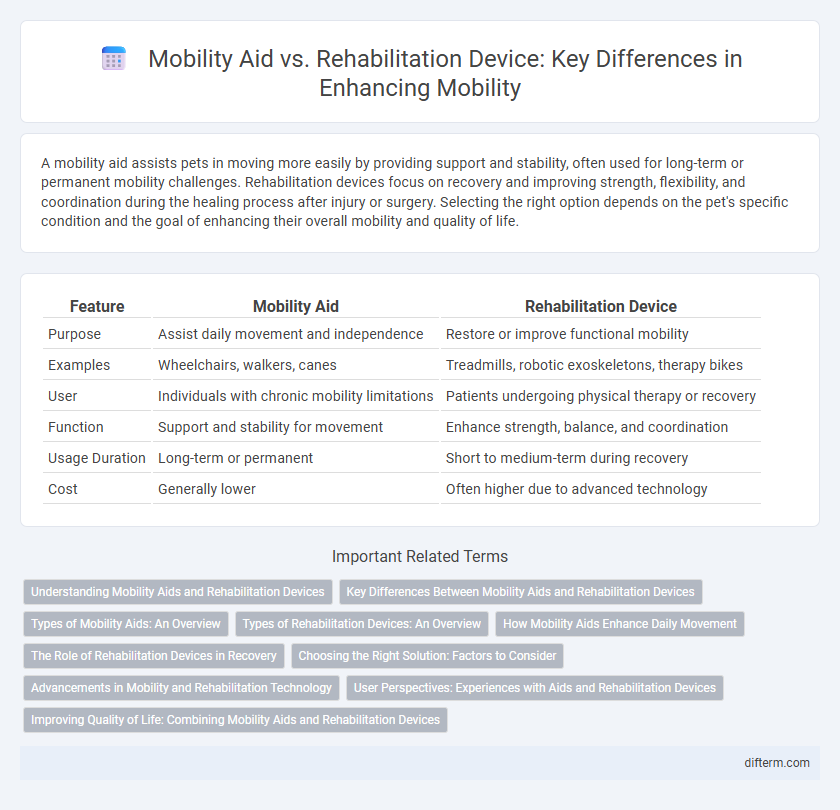A mobility aid assists pets in moving more easily by providing support and stability, often used for long-term or permanent mobility challenges. Rehabilitation devices focus on recovery and improving strength, flexibility, and coordination during the healing process after injury or surgery. Selecting the right option depends on the pet's specific condition and the goal of enhancing their overall mobility and quality of life.
Table of Comparison
| Feature | Mobility Aid | Rehabilitation Device |
|---|---|---|
| Purpose | Assist daily movement and independence | Restore or improve functional mobility |
| Examples | Wheelchairs, walkers, canes | Treadmills, robotic exoskeletons, therapy bikes |
| User | Individuals with chronic mobility limitations | Patients undergoing physical therapy or recovery |
| Function | Support and stability for movement | Enhance strength, balance, and coordination |
| Usage Duration | Long-term or permanent | Short to medium-term during recovery |
| Cost | Generally lower | Often higher due to advanced technology |
Understanding Mobility Aids and Rehabilitation Devices
Mobility aids such as wheelchairs, walkers, and crutches provide immediate support and enhanced independence by assisting physical movement for individuals with mobility impairments. Rehabilitation devices like therapeutic exercise equipment and functional electrical stimulation systems focus on restoring strength, improving motor skills, and promoting neuromuscular recovery during the rehabilitation process. Understanding the distinct roles of mobility aids versus rehabilitation devices is crucial for tailoring personalized intervention plans aimed at maximizing functional mobility and long-term recovery outcomes.
Key Differences Between Mobility Aids and Rehabilitation Devices
Mobility aids such as wheelchairs, walkers, and canes are designed primarily to assist individuals in moving around more independently by compensating for physical limitations. Rehabilitation devices, including therapy bands, exercise bikes, and balance trainers, focus on restoring or improving mobility through targeted physical therapy and exercises. The key difference lies in the purpose: mobility aids provide immediate support for daily movement, whereas rehabilitation devices aim to enhance strength, coordination, and overall function over time.
Types of Mobility Aids: An Overview
Mobility aids include devices such as wheelchairs, canes, walkers, and crutches designed to assist individuals in moving more independently and safely. Rehabilitation devices, often integrated with therapeutic functions, focus on restoring mobility and strength through tools like gait trainers and functional electrical stimulation systems. Understanding the distinct roles of mobility aids and rehabilitation devices is critical for selecting appropriate support based on user needs and rehabilitation goals.
Types of Rehabilitation Devices: An Overview
Types of rehabilitation devices encompass a wide range of tools designed to restore movement and function, including orthotic braces, prosthetics, and therapeutic exercise equipment. These devices target specific impairments by supporting muscle strength, joint alignment, and motor control, often integrating advanced technologies like robotics and biofeedback systems. Unlike general mobility aids such as walkers or canes, rehabilitation devices are specialized for active treatment and recovery within physical therapy programs.
How Mobility Aids Enhance Daily Movement
Mobility aids such as walkers, canes, and wheelchairs provide immediate support to individuals with limited movement, promoting independence and reducing fatigue during daily activities. These devices enhance stability and safety, allowing users to navigate various environments with greater confidence. Unlike rehabilitation devices that focus on recovery and physical improvement, mobility aids are designed to assist ongoing movement and improve quality of life in real-time.
The Role of Rehabilitation Devices in Recovery
Rehabilitation devices play a critical role in aiding recovery by enhancing mobility and promoting functional independence after injury or surgery. These devices facilitate targeted physical therapy by supporting muscle strengthening, joint flexibility, and coordination, accelerating the rehabilitation process. Unlike basic mobility aids that primarily assist movement, rehabilitation devices actively contribute to restoring mobility through therapeutic interventions.
Choosing the Right Solution: Factors to Consider
Choosing the right mobility aid versus a rehabilitation device depends on the individual's specific needs, level of mobility impairment, and long-term recovery goals. Mobility aids like walkers or wheelchairs provide immediate support for movement and independence, while rehabilitation devices focus on therapeutic exercises to restore function and strength. Evaluating factors such as the severity of mobility limitation, user comfort, and the potential for improvement helps determine the most effective solution.
Advancements in Mobility and Rehabilitation Technology
Advancements in mobility aids such as powered wheelchairs and smart prosthetics have significantly enhanced user independence by integrating sensors and AI for adaptive support. Rehabilitation devices now incorporate virtual reality and robotic exoskeletons, enabling precise movement therapy and real-time progress tracking. These technologies collectively accelerate recovery and improve long-term mobility outcomes for patients with diverse physical impairments.
User Perspectives: Experiences with Aids and Rehabilitation Devices
Users often report that mobility aids such as walkers and wheelchairs provide immediate support and enhance independence in daily tasks, while rehabilitation devices focus on long-term recovery and improving physical function. Experiences highlight the importance of comfort, ease of use, and personalized fit in both categories to maximize effectiveness and user satisfaction. Feedback underscores the need for seamless integration of these tools into users' lifestyles to promote sustained mobility and confidence.
Improving Quality of Life: Combining Mobility Aids and Rehabilitation Devices
Mobility aids such as wheelchairs and walkers provide immediate support for individuals with movement impairments, enhancing daily independence and reducing fall risk. Rehabilitation devices, including robotic exoskeletons and therapeutic exercise equipment, promote muscle strength and functional recovery, facilitating long-term mobility improvements. Integrating these tools creates a comprehensive approach that significantly improves overall quality of life by addressing both immediate mobility needs and ongoing rehabilitation goals.
mobility aid vs rehabilitation device Infographic

 difterm.com
difterm.com